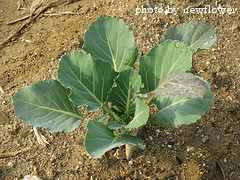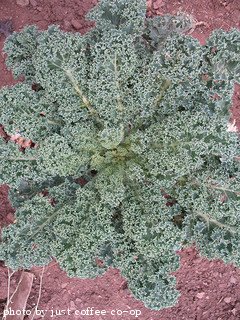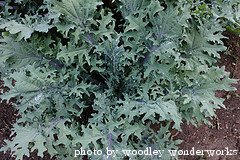Fertilizing and Watering Kale
When watering kale, the key is to keep the soil evenly moist. Kale will do well with a single application of balanced fertilizer after the first harvest.
The main concept behind watering and fertilizng kale is that you want to make sure the plants have access to all the nutrients they need and are able to easily absorb those nutrients.
Watering Kale
If possible, use mulch to keep the soil cool and moist. This will cut down on the amount you have to water. Grass clippings and compost work well as mulch, as do shredded newspapers and stray. If you get a decent rain shower every week or so, your kale crop will likely do fine on its own and you won't have to water. If you don't get rain for awhile, you'll need to water the plants yourself. A sprinkler works well for larger patches and only needs to run 10-15 minutes to get the soil moist enough. For just a few plants, use a light spray from a hose or water with a jug or can. Don't over-water! Kale plants don't do well if they sit in soggy soil for extended periods. The idea is to keep the first few inches of soil evenly moist.
Before watering kale, use your fingers to dig down a few inches into the soil next to the plants. You want the soil at this depth to be moist, but not wet. Squeeze a handful of soil in your palm. If it is moist enough to hold together for a few seconds before falling apart, you're in good shape and you can check again in a few days if you don't get any rain. If the soil is soggy and you're able to squeeze water out of it, let it dry out for a few days and check again. If the soil is bone dry and doesn't hold together at all when you squeeze it, it's time to water.

Fertilizing Kale
If you amend your soil before planting, you probably won't have to add fertilizer unless your soil is nutrient-deficient. In our own garden, we add a balanced granular fertilizer before we plant our kale seeds.
About a week before we plant, we scatter the fertilizer at a rate of 1 pint per 100 square feet. We also scatter pulverized limestone as our soil is lacking calcium and is a bit acidic. We till these additives in and water them down to help them begin to break down in the soil. About a week later, we till one last time and then create our rows and plant our seeds.
Compost works well
for mulch and it also slowly adds nutrients to the soil that can be
retrieved by the roots of kale plants. If you want to use a commercial fertilizer product, granular and water-soluble types work well. Pay
attention to the 3 number code on the label fertilizer. These three
numbers indicate the amount of nitrogen, phosphate and potassium that
are contained in that particular fertilizer, respectively. For instance,
a 10-10-10 fertilizer contains 10% nitrogen, 10% phosphate and 10%
potassium. A 5-10-10 bag would contain 5% percent nitrogen. A 10-5-10
bag would contain 10% nitrogen, 5% phosphate and 10% potassium. For
kale, use something that is well-balanced. 10-10-10 works just fine.
If using a granular product, apply it as a side dressing. This means scattering the fertilizer down the middle of the row and to the side of the plants. You don't want a granular fertilizer coming in direct contact with the plants because it could burn them.

After laying out the fertilizer to the side, water it in well. The nutrients will leech into the soil and be absorbed by the plants. For kale, most granular products are spread at a rate of 1 pound per 100 square feet.
You can also apply a water-soluble product, something like Miracle Gro. Just mix it according to the manufacturer's instructions and apply when you would normally be watering kale plants anyway. With water-soluble products, it's fine if the mix gets onto the leaves.
Unless you have an extremely long growing season, kale plants need just 1 dose of fertilizer and it's usually applied after the first leaves are harvested. This gives the plants the boost they need to keep producing. In our own garden we apply a light side dressing of granular fertilizer the day after we harvest the first kale leaves.
Now that you know about fertilizing and watering kale, it's time to think about harvesting those lovely leaves.

Click here to learn about harvesting kale
Click here for information on different kale varieties
Click here for some of our favorite kale recipes
Click here to move from our Watering Kale page to our Growing Kale main page